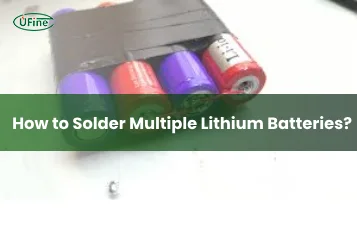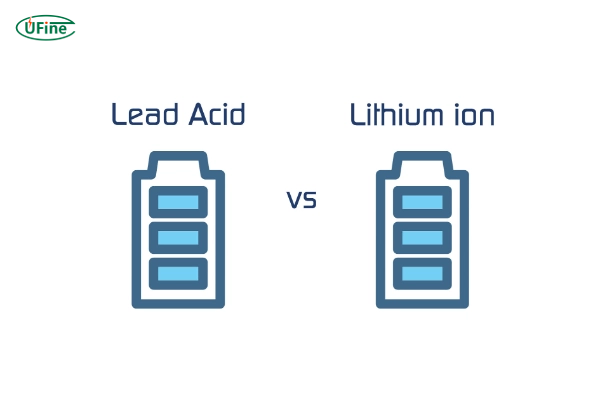Lead acid and lithium-ion batteries dominate the market. This article offers a detailed comparison, covering chemistry, construction, pros, cons, applications, and operation. It also discusses critical factors for battery selection.
Part 1. Lead-acid batteries
Chemistry and Construction
Lead acid batteries comprise lead plates immersed in an electrolyte sulfuric acid solution. The battery consists of multiple cells containing positive and negative plates. Lead and lead dioxide compose these plates, reacting with the electrolyte to generate electrical energy.
Advantages:
- Cost-effective: Lead-acid batteries are relatively inexpensive compared to other battery types, making them a popular choice for various applications.
- Robust and durable: They can withstand harsh environmental conditions and have a long service life.
- Wide availability: Lead acid batteries are widely available in different sizes and capacities.
- Recyclable: These batteries are highly recyclable, making them an environmentally friendly option.
Disadvantages:
- Heavy and bulky: Lead acid batteries are heavy and take up significant space, which can be a limitation in specific applications.
- Limited energy density: They have a lower energy density than lithium-ion batteries, resulting in a lower capacity and shorter runtime.
- Maintenance requirements: Lead acid batteries require periodic maintenance, including electrolyte level checks and occasional equalization charging.
Applications
Lead acid batteries find applications in various industries and sectors, including:
- Automotive industry for starting, lighting, and ignition (SLI) systems.
- Renewable energy systems, such as solar and wind power storage.
- Uninterruptible power supply (UPS) systems for backup power during outages.
- Electric forklifts and other material handling equipment.
- Marine and recreational vehicles.
Part 2. Lithium-ion batteries
Chemistry and Structure
Lithium-ion batteries employ lithium compounds as the active material for both the positive and negative electrodes. These batteries consist of a positive electrode (cathode) made of lithium cobalt oxide, a negative electrode (anode) typically composed of graphite and a separator that prevents direct contact between the electrodes. The electrolyte in lithium-ion batteries is a lithium salt dissolved in an organic solvent.
Pros:
- High energy density: Lithium-ion batteries offer a significantly higher energy density than lead acid batteries, resulting in a greater capacity and longer runtime.
- Lightweight and compact: Lithium-ion batteries are lightweight and have a compact design, making them suitable for portable applications.
- Low self-discharge: They have a lower rate, meaning they retain their charge for a more extended period when not in use.
- Fast charging: Lithium-ion batteries can be charged at a higher rate, allowing faster charging times than lead-acid batteries.
- No maintenance: Unlike lead-acid batteries, lithium-ion batteries are maintenance-free, eliminating the need for regular upkeep.
Cons:
- Higher cost: Lithium-ion batteries are more expensive than lead-acid batteries.
- Safety concerns: Although rare, lithium-ion batteries can be prone to thermal runaway and require proper handling and protection circuits.
- Limited shelf life: Lithium-ion batteries can lose capacity over time, even when not in use.
Applications
Lithium-ion batteries are extensively used in a wide range of applications, including:
- Consumer electronics such as smartphones, laptops, and tablets.
- Electric vehicles (EVs) and hybrid electric vehicles (HEVs).
- Aerospace applications, including satellites and aircraft.
- Energy storage systems for renewable energy integration.
- Medical devices and portable healthcare equipment.
Part 3. Compare lead-acid batteries with lithium-ion batteries
Material:
Lead-acid batteries typically use lead plates and sulfuric acid electrolytes, whereas lithium-ion batteries contain lithium compounds like lithium cobalt oxide, lithium iron phosphate, or lithium manganese oxide.
Cost:
Lead-acid batteries are generally less expensive upfront compared to lithium-ion batteries. For example, a typical lead-acid battery might cost around $100-$200 per kilowatt-hour (kWh) capacity. In contrast, a lithium-ion battery could range from $300 to $500 per kWh.
Battery Capacity:
Lithium-ion batteries tend to have higher energy density and thus offer greater battery capacity than lead-acid batteries of similar sizes. A lead-acid battery might have a 30-40 watt-hours capacity per kilogram (Wh/kg), whereas a lithium-ion battery could have a 150-200 Wh/kg capacity.
Energy Density or Specific Energy:
Lithium-ion batteries have a higher energy density or specific energy, meaning they can store more energy per unit volume or weight than lead-acid batteries. A lead-acid battery might have an energy density of 30-40 watt-hours per liter (Wh/L), while a lithium-ion battery could have an energy density of 150-200 Wh/L.
Weight and Size:
Lithium-ion batteries are lighter and more compact than lead-acid batteries for the same energy storage capacity. For example, a lead-acid battery might weigh 20-30 kilograms (kg) per kWh, while a lithium-ion battery could weigh only 5-10 kg per kWh.
Depth of Discharge (DOD):
Lithium-ion batteries typically allow for deeper discharges without significantly affecting their lifespan compared to lead-acid batteries. A lead-acid battery might have a recommended maximum DOD of 50%. A lithium-ion battery could safely discharge 80% or more of its capacity.
Durability:
Lithium-ion batteries are generally more durable and can withstand more charge-discharge cycles than lead-acid batteries. A lead-acid battery might last 300-500 cycles, whereas a lithium-ion battery could last for 1000 cycles or more.
Cycle Life:
Lithium-ion batteries often outlast lead-acid batteries in cycle life, allowing for more charges and discharges before their capacity significantly degrades. A lead-acid battery might have a cycle life of 3-5 years, while a lithium-ion battery could last 5-10 years or longer.
Charging Time:
Lithium-ion batteries generally have shorter charging times than lead-acid batteries, which can take longer to recharge fully. A lead-acid battery requires 8-10 hours for a full charge, while a lithium-ion battery can charge fully in 2-4 hours.
Safety:
Lithium-ion batteries are considered safer due to their reduced risk of leakage and environmental damage compared to lead-acid batteries, which contain corrosive acids and heavy metals. Additionally, lithium-ion batteries have built-in safety features like thermal runaway protection.
Part 4. How do lead-acid batteries work?
Lead acid batteries function through a chemical reaction between the lead plates and the sulfuric acid electrolyte. When the battery discharges, the lead plates react with the electrolyte, producing lead sulfate and releasing electrical energy. The process is reversed during charging, converting lead sulfate into lead and lead dioxide. This reversible reaction enables lead acid batteries to undergo multiple recharges and discharges.
Part 5. How do lithium-ion batteries work?
Lithium-ion batteries operate based on the movement of lithium ions between the positive and negative electrodes. Lithium ions travel from the negative electrode (anode) through the electrolyte to the positive electrode (cathode), generating electrical energy during discharging. When the battery charges, it stores the lithium ions at the negative electrode for future discharging cycles. This movement of lithium ions enables the reversible operation of lithium-ion batteries.
Part 6. Lead-acid vs. Lithium-ion batteries: considerations for battery selection
When selecting between lead acid batteries and lithium-ion batteries, consider the following factors:
- Application requirements: Evaluate the application’s specific power and energy demands and any weight or space constraints.
- Runtime and capacity: Determine the required runtime and capacity needed for the application to ensure uninterrupted operation.
- Lifecycle cost: Consider not only the upfront cost but also the long-term cost, including maintenance, lifespan, and energy efficiency.
- Environmental impact: Assess the ecological considerations, such as recyclability and overall sustainability goals.
- Safety considerations: Evaluate the safety requirements and precautions needed for the application, especially when dealing with lithium-ion batteries.
Part 7. FAQs
-
Which is better, a lithium-ion or lead-acid battery?
It depends on your specific needs. Lithium-ion batteries generally offer higher energy density and longer lifespan. For example, a lithium-ion battery might last 2-3 times longer than a lead-acid battery under similar conditions. -
Why do cars use lead-acid batteries instead of lithium?
Cars traditionally use lead-acid batteries because they are cost-effective and reliable for starting engines. A typical lead-acid battery for a car might cost around $50-$150. In contrast, a lithium-ion battery could range from $200 to $500 or more. -
What battery lasts longer, lead-acid or lithium?
Generally, lithium-ion batteries have a longer lifespan and can endure more charge-discharge cycles than lead-acid batteries. A lead-acid battery might last 3-5 years, while a lithium-ion battery could last 5-10 years or longer. -
Can I replace a lead-acid battery with lithium-ion?
Yes, replacing a lead-acid battery with a lithium-ion battery is possible in some applications. However, ensuring that the lithium-ion battery is compatible with the system’s voltage and charging requirements is essential. -
Which lead-acid battery is best?
The best lead-acid battery depends on the application, required capacity, and budget. Some popular brands known for quality lead-acid batteries include Trojan, Exide, and Yuasa. A high-quality lead-acid battery might cost around $100-$200 per kilowatt-hour (kWh) capacity. -
Which is safer, lead acid or lithium?
Both lead-acid and lithium-ion batteries can be safe if handled correctly. However, if mishandled, lead-acid batteries contain corrosive acids and heavy metals, posing environmental and health risks. Lithium-ion batteries have a rare risk of thermal runaway or fire. Still, proper handling, storage, and charging protocols significantly mitigate these risks.
Related Tags:
More Articles

How to Correctly Solder Multiple Lithium Batteries Together?
Learn step-by-step how to solder lithium batteries in series or parallel safely and effectively with this detailed, hands-on guide.
Choosing Batteries for Trolling Motors Lightweight: Charger Options
Lithium batteries are best for trolling motors as they are lightweight long long-lasting, and efficient. This guide covers selection, charging, and care tips.
Finding 11.1 V LiPo Battery Near Me: B2B Supplier Strategies
Need 11.1V LiPo batteries near you? This guide helps B2B buyers source reliable suppliers, compare specs, and ensure safe, cost-effective deals.
11.1 V LiPo Battery 5000 mAh: Specs That Matter for Industrial Use
An 11.1V 5000mAh LiPo battery offers high capacity and stable power, ideal for drones, robotics, and industrial tools requiring long runtimes.
Lightweight Battery Packs for Trolling Motors: Top Features
Looking for the best lightweight trolling motor battery? This guide covers top features, battery types, and tips to boost your boating performance.




